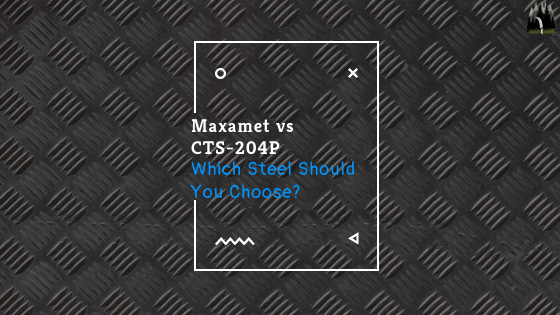Maxamet and CTS-204P are two premium steels–so it makes sense to compare them to find the best steel for your needs. In this article, we’re going to dive into which one is better, why, and which you should choose.
Here’s the short answer:
Maxamet is known for extreme edge retention. CTS-204P has pretty good edge retention, great corrosion resistance, and is decently easy to sharpen. Neither one is very tough, but CTS-204P is tougher than Maxamet. If you need to do a lot of slicing, choose Maxamet. Otherwise, CTS-204P is better.
With the short answer out of the way, let’s take a closer look at each steel.
Deep Dive on Maxamet
Maxamet is a relatively new steel that was developed by Carpenter Technology. It is known for having great edge retention, but being too great at anything else. Maxamet’s steel composition is proprietary, but it’s believed to be something like the following:
- 2.15% carbon,
- 4.75% chromium,
- 10% cobalt,
- 0.3% manganese,
- 13% tungsten, and
- 6% vanadium.
Carbon helps to improve wear resistance and strength (though too much carbon can lead to brittleness). Chromium helps with corrosion resistance, but Maxamet has a fairly low chromium content, which means it’s not very corrosion resistant. Cobalt, tungsten, manganese, and vanadium all help increase the strength and wear resistance of the steel.
Maxamet is known for having extreme edge retention, but not being too good in any other segment. Having great edge retention usually comes from the blade having high hardness, which means that Maxamet can be susceptible to chipping (thus, it’s not very tough). It’s also pretty expensive because of the complex manufacturing process used to make it. Maxamet also corrodes extremely easily. If you plan on using it in a humid environment, it’s best to keep it well-oiled (or to look for a different steel).
Deep Dive on CTS-204P
CTS-204P is another steel developed by Carpenter Technology, but it’s quite a bit different than Maxamet. CTS-204P has great corrosion resistance, decent sharpenability, and decent toughness. Its edge retention, while not as good as Maxamet’s, still makes it a great option for slicing tasks.
The composition of CTS-204P includes:
- 1.9% carbon,
- 20% chromium,
- 4% vanadium,
- 1% molybdenum, and
- 0.6% silicon.
Molybdenum helps with hardenability, which helps to make the steel easier to manufacture. Silicon helps to increase the strength and hardness of a steel, similar to carbon.
Maxamet versus CTS-204P
Maxamet is better in terms of in edge retention, which makes it a great choice for cutting and slicing tasks. However, a edge retention and ease of sharpening are usually negatively correlated. Thus, Maxamet is pretty hard to sharpen. CTS-204P, on the other hand, has a good balance of sharpenability and edge retention. Its edge retention isn’t as good as Maxamet’s, but it can still hold its own.
In terms of corrosion resistance, CTS-204P absolutely outperforms Maxamet. Maxamet is one of the least corrosion resistant steels out there.
Finally, with regards to toughness, CTS-204P is better than Maxamet. Toughness in steel comes from a steel being on the softer side of things (the harder it is, the more brittle and likely to crack and break it is; and thus vice versa). So, while neither one is particularly tough, CTS-204P is comparatively tougher than Maxamet.
Conclusion
Ultimately, if you need something for slicing and cutting tasks, Maxamet is the better option. Just make sure to keep it well-oiled if you work in a humid environment. If you need more corrosion resistance, while still having pretty good edge retention, then CTS-204P is the better option.
If you’d like to read more about all things related to knives, check out our other articles here.

